
Mankiw Macroeconomics (5th ed)
.pdf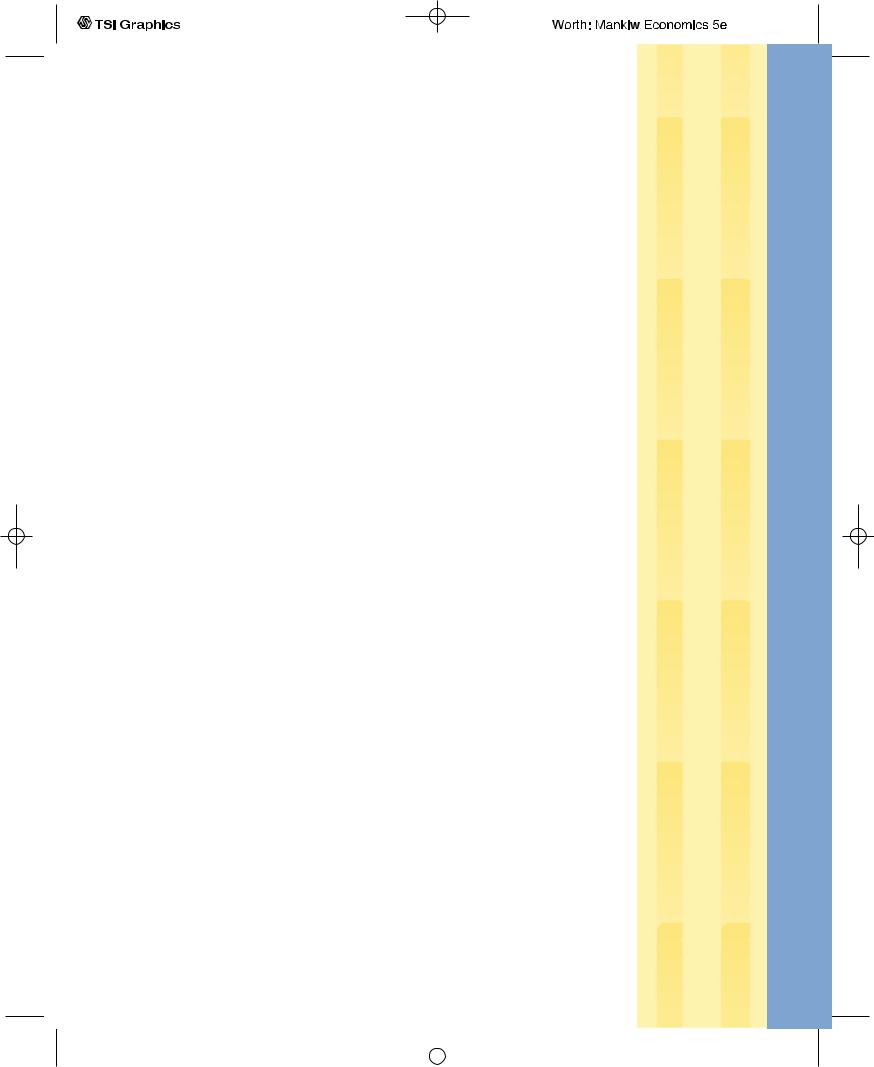
part V
Macroeconomic
Policy Debates
User JOEWA:Job EFF01430:6264_ch14:Pg 379:23155#/eps at 100% *23155* |
Mon, Feb 18, 2002 1:02 AM |
|||
|
|
|
|
|
|
|
|
|
|
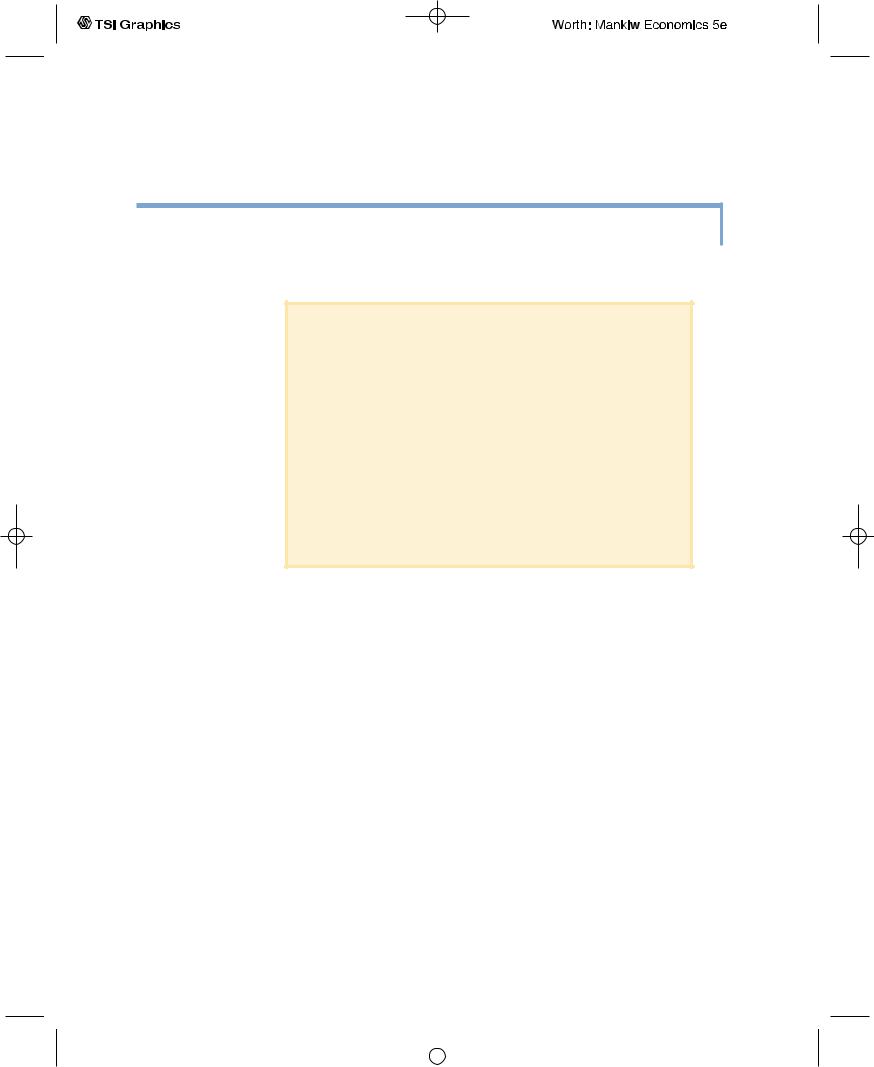
C H A P T1E R 4F O U R T E E N
Stabilization Policy
The Federal Reserve’s job is to take away the punch bowl just as the party
gets going.
— William McChesney Martin
What we need is not a skilled monetary driver of the economic vehicle con-
tinuously turning the steering wheel to adjust to the unexpected irregulari-
ties of the route, but some means of keeping the monetary passenger who is
in the back seat as ballast from occasionally leaning over and giving the
steering wheel a jerk that threatens to send the car off the road.
— Milton Friedman
How should government policymakers respond to the business cycle? The two quotations above—the first from a former chairman of the Federal Reserve, the second from a prominent critic of the Fed—show the diversity of opinion over how this question is best answered.
Some economists, such as William McChesney Martin, view the economy as inherently unstable.They argue that the economy experiences frequent shocks to aggregate demand and aggregate supply. Unless policymakers use monetary and fiscal policy to stabilize the economy, these shocks will lead to unnecessary and inefficient fluctuations in output, unemployment, and inflation.According to the popular saying, macroeconomic policy should “lean against the wind,’’ stimulating the economy when it is depressed and slowing the economy when it is overheated.
Other economists, such as Milton Friedman, view the economy as naturally stable. They blame bad economic policies for the large and inefficient fluctuations we have sometimes experienced.They argue that economic policy should not try to “fine-tune’’ the economy. Instead, economic policymakers should admit their limited abilities and be satisfied if they do no harm.
This debate has persisted for decades, with numerous protagonists advancing various arguments for their positions.The fundamental issue is how policymakers should use the theory of short-run economic fluctuations developed in the
380 |
User JOEWA:Job EFF01430:6264_ch14:Pg 380:24427#/eps at 100% *24427* |
Mon, Feb 18, 2002 1:02 AM |
|||
|
|
|
|
|
|
|
|
|
|

C H A P T E R 1 4 Stabilization Policy | 381
preceding chapters. In this chapter we ask two questions that arise in this debate. First, should monetary and fiscal policy take an active role in trying to stabilize the economy, or should policy remain passive? Second, should policymakers be free to use their discretion in responding to changing economic conditions, or should they be committed to following a fixed policy rule?
14-1 Should Policy Be Active or Passive?
Policymakers in the federal government view economic stabilization as one of their primary responsibilities.The analysis of macroeconomic policy is a regular duty of the Council of Economic Advisers, the Congressional Budget Office, the Federal Reserve, and other government agencies. When Congress or the president is considering a major change in fiscal policy, or when the Federal Reserve is considering a major change in monetary policy, foremost in the discussion are how the change will influence inflation and unemployment and whether aggregate demand needs to be stimulated or restrained.
Although the government has long conducted monetary and fiscal policy, the view that it should use these policy instruments to try to stabilize the economy is more recent. The Employment Act of 1946 was a key piece of legislation in which the government first held itself accountable for macroeconomic performance. The act states that “it is the continuing policy and responsibility of the Federal Government to . . . promote full employment and production.’’This law was written when the memory of the Great Depression was still fresh.The lawmakers who wrote it believed, as many economists do, that in the absence of an active government role in the economy, events such as the Great Depression could occur regularly.
To many economists the case for active government policy is clear and simple. Recessions are periods of high unemployment, low incomes, and increased economic hardship.The model of aggregate demand and aggregate supply shows how shocks to the economy can cause recessions. It also shows how monetary and fiscal policy can prevent recessions by responding to these shocks.These economists consider it wasteful not to use these policy instruments to stabilize the economy.
Other economists are critical of the government’s attempts to stabilize the economy. These critics argue that the government should take a hands-off approach to macroeconomic policy.At first, this view might seem surprising. If our model shows how to prevent or reduce the severity of recessions, why do these critics want the government to refrain from using monetary and fiscal policy for economic stabilization? To find out, let’s consider some of their arguments.
Lags in the Implementation and Effects of Policies
Economic stabilization would be easy if the effects of policy were immediate. Making policy would be like driving a car: policymakers would simply adjust their instruments to keep the economy on the desired path.
User JOEWA:Job EFF01430:6264_ch14:Pg 381:27867#/eps at 100% *27867* |
Mon, Feb 18, 2002 1:02 AM |
|||
|
|
|
|
|
|
|
|
|
|
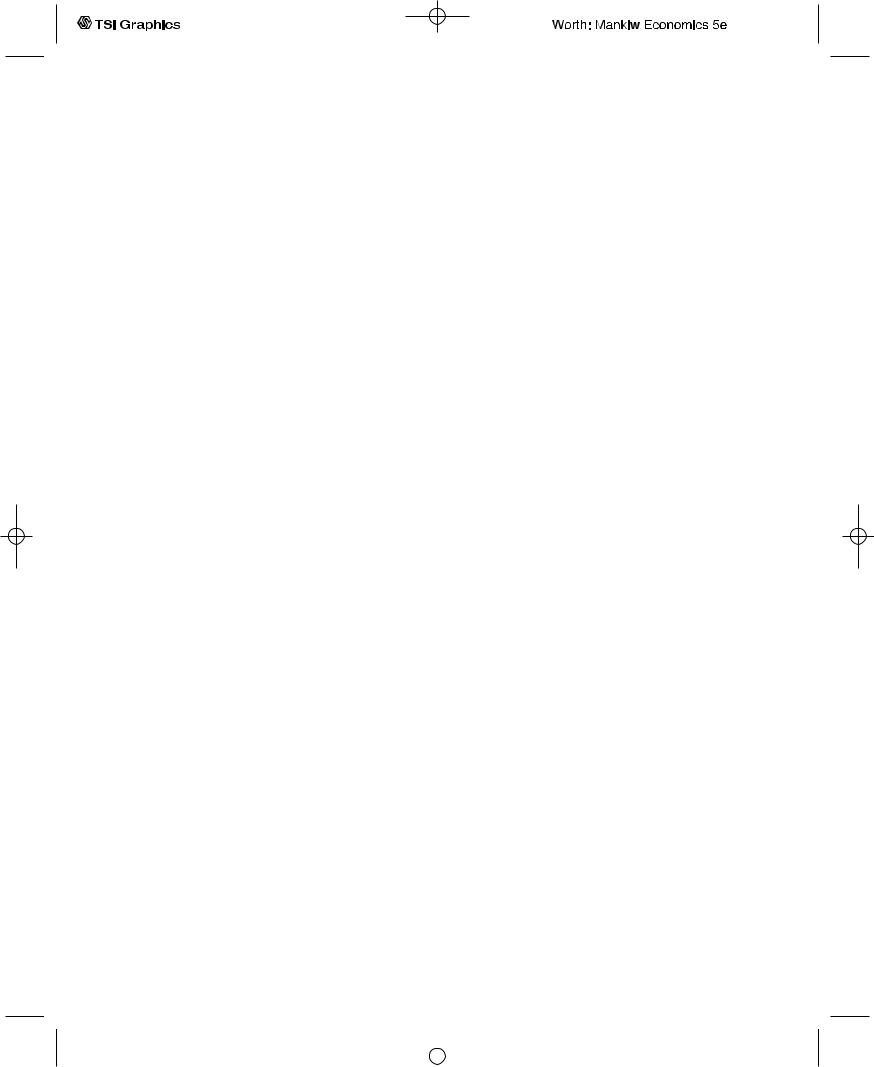
382 | P A R T V Macroeconomic Policy Debates
Making economic policy, however, is less like driving a car than it is like piloting a large ship. A car changes direction almost immediately after the steering wheel is turned. By contrast, a ship changes course long after the pilot adjusts the rudder, and once the ship starts to turn, it continues turning long after the rudder is set back to normal. A novice pilot is likely to oversteer and, after noticing the mistake, overreact by steering too much in the opposite direction.The ship’s path could become unstable, as the novice responds to previous mistakes by making larger and larger corrections.
Like a ship’s pilot, economic policymakers face the problem of long lags. Indeed, the problem for policymakers is even more difficult, because the lengths of the lags are hard to predict. These long and variable lags greatly complicate the conduct of monetary and fiscal policy.
Economists distinguish between two lags in the conduct of stabilization policy: the inside lag and the outside lag.The inside lag is the time between a shock to the economy and the policy action responding to that shock. This lag arises because it takes time for policymakers first to recognize that a shock has occurred and then to put appropriate policies into effect.The outside lag is the time between a policy action and its influence on the economy. This lag arises because policies do not immediately influence spending, income, and employment.
A long inside lag is a central problem with using fiscal policy for economic stabilization.This is especially true in the United States, where changes in spending or taxes require the approval of the president and both houses of Congress. The slow and cumbersome legislative process often leads to delays, which make fiscal policy an imprecise tool for stabilizing the economy. This inside lag is shorter in countries with parliamentary systems, such as the United Kingdom, because there the party in power can often enact policy changes more rapidly.
Monetary policy has a much shorter inside lag than fiscal policy, because a central bank can decide on and implement a policy change in less than a day, but monetary policy has a substantial outside lag. Monetary policy works by changing the money supply and thereby interest rates, which in turn influence investment. But many firms make investment plans far in advance.Therefore, a change in monetary policy is thought not to affect economic activity until about six months after it is made.
The long and variable lags associated with monetary and fiscal policy certainly make stabilizing the economy more difficult.Advocates of passive policy argue that, because of these lags, successful stabilization policy is almost impossible. Indeed, attempts to stabilize the economy can be destabilizing. Suppose that the economy’s condition changes between the beginning of a policy action and its impact on the economy. In this case, active policy may end up stimulating the economy when it is overheated or depressing the economy when it is cooling off. Advocates of active policy admit that such lags do require policymakers to be cautious. But, they argue, these lags do not necessarily mean that policy should be completely passive, especially in the face of a severe and protracted economic downturn.
Some policies, called automatic stabilizers, are designed to reduce the lags associated with stabilization policy.Automatic stabilizers are policies that stimulate or depress the economy when necessary without any deliberate policy change. For
User JOEWA:Job EFF01430:6264_ch14:Pg 382:27868#/eps at 100% *27868* |
Mon, Feb 18, 2002 1:02 AM |
|||
|
|
|
|
|
|
|
|
|
|

C H A P T E R 1 4 Stabilization Policy | 383
example, the system of income taxes automatically reduces taxes when the economy goes into a recession, without any change in the tax laws, because individuals and corporations pay less tax when their incomes fall. Similarly, the unemploymentinsurance and welfare systems automatically raise transfer payments when the economy moves into a recession, because more people apply for benefits. One can view these automatic stabilizers as a type of fiscal policy without any inside lag.
The Difficult Job of Economic Forecasting
Because policy influences the economy only after a long lag, successful stabilization policy requires the ability to predict accurately future economic conditions. If we cannot predict whether the economy will be in a boom
or a recession in six months or a year, we cannot evaluate whether monetary and fiscal policy should now be trying to expand or contract aggregate demand. Unfortunately, economic developments are often unpredictable, at least given our current understanding of the economy.
One way forecasters try to look ahead is with leading indicators. A leading indicator is a data series that fluctuates in advance of the economy. A large fall in a leading indicator signals that a recession is more likely.
Another way forecasters look ahead is with macroeconometric models, which have been developed both by government agencies and by private firms for forecasting and policy analysis. As we discussed in Chapter 11,
© 1988 |
Inc. |
by Dana Fradon; |
Yorker Magazine, |
Drawing |
The New |
FYIWhat’s in the Index of Leading Economic
Indicators?
Each month the Conference Board, a private economics research group, announces the index of leading economic indicators. This index is made up from 10 data series that are often used to forecast changes in economic activity about six to nine months ahead. Here is a list of the series. Can you explain why each of these might help predict changes in real GDP?
1.Average workweek of production workers in manufacturing.
2.Average initial weekly claims for unemployment insurance. This series is inverted in computing the index, so that a decrease in the series raises the index.
3.New orders for consumer goods and materials, adjusted for inflation.
4.Vendor performance. This is a measure of the number of companies receiving slower deliveries from suppliers.
5.New orders, nondefense capital goods.
6.New building permits issued.
7.Index of stock prices.
8.Money supply (M2), adjusted for inflation.
9.Interest rate spread: the yield spread between 10-year Treasury notes and 3-month Treasury bills.
10.Index of consumer expectations.
User JOEWA:Job EFF01430:6264_ch14:Pg 383:27869#/eps at 100% *27869* |
Mon, Feb 18, 2002 1:02 AM |
|||
|
|
|
|
|
|
|
|
|
|
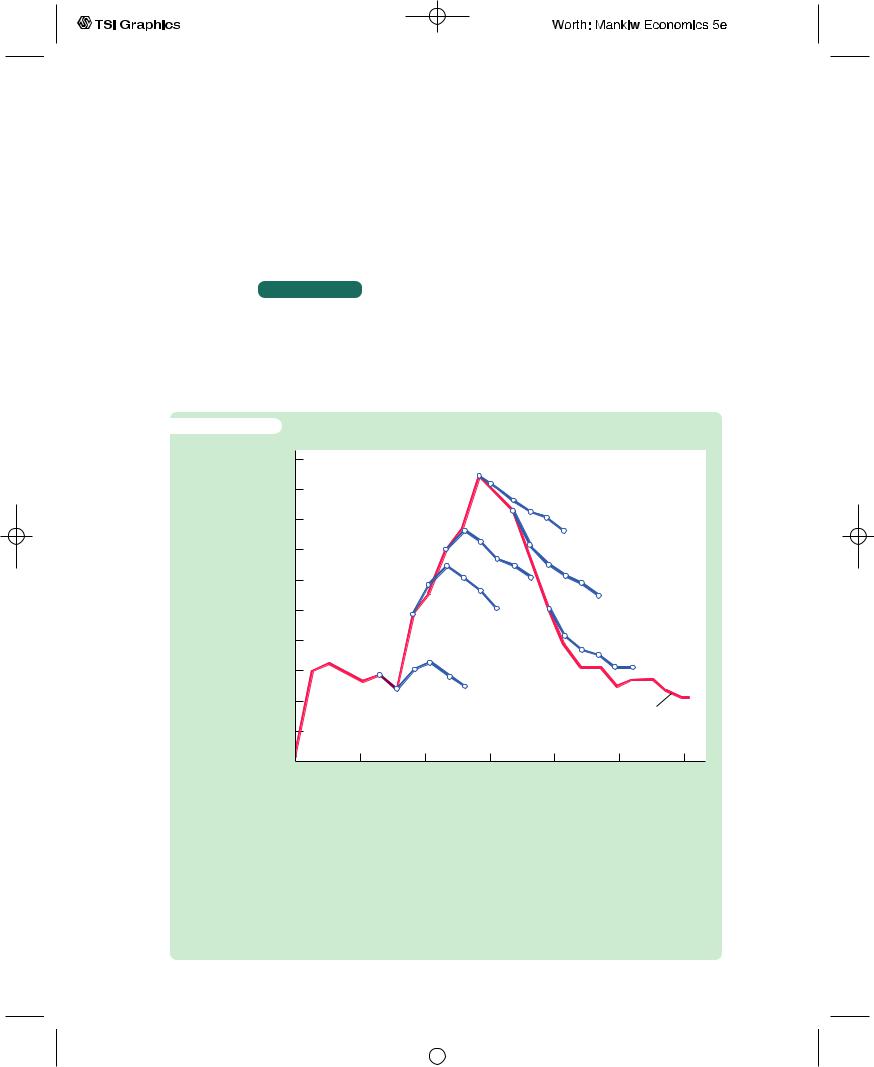
384 | P A R T V Macroeconomic Policy Debates
these large-scale computer models are made up of many equations, each representing a part of the economy. After making assumptions about the path of the exogenous variables, such as monetary policy, fiscal policy, and oil prices, these models yield predictions about unemployment, inflation, and other endogenous variables. Keep in mind, however, that the validity of these predictions is only as good as the model and the forecasters’ assumptions about the exogenous variables.
C A S E S T U D Y
Mistakes in Forecasting
“Light showers, bright intervals, and moderate winds.”This was the forecast offered by the renowned British national weather service on October 14, 1987. The next day Britain was hit by the worst storm in more than two centuries.
f i g u r e 1 4 - 1 |
|
|
|
|
|
|
|
Unemployment |
11.0 |
|
|
|
|
|
|
rate (percent) |
|
|
|
|
|
|
|
|
10.5 |
|
|
|
|
|
|
|
10.0 |
|
|
|
|
|
|
|
9.5 |
|
|
|
|
|
|
|
9.0 |
|
|
|
|
|
|
|
8.5 |
|
|
|
1983:2 |
|
|
|
|
|
|
|
|
|
|
|
8.0 |
|
|
|
|
|
|
|
7.5 |
|
|
|
|
|
1983:4 |
|
|
|
|
|
|
|
|
|
7.0 |
|
1981:2 |
|
|
|
|
|
|
|
|
|
|
Actual |
|
|
|
|
|
|
|
|
|
|
6.5 |
|
|
|
|
|
|
|
6.0 |
1981 |
1982 |
1983 |
1984 |
1985 |
1986 |
|
1980 |
||||||
|
|
|
|
|
|
|
Year |
Forecasting the Recession of 1982 The red line shows the actual unemployment rate from the first quarter of 1980 to the first quarter of 1986. The blue lines show the unemployment rate predicted at six points in time: the second quarter of 1981, the fourth quarter of 1981, the second quarter of 1982, and so on. For each forecast, the symbols mark the current unemployment rate and the forecast for the subsequent five quarters. Notice that the forecasters failed to predict both the rapid rise in the unemployment rate and the subsequent rapid decline.
Source: The unemployment rate is from the Department of Commerce. The predicted unemployment rate is the median forecast of about 20 forecasters surveyed by the American Statistical Association and the National Bureau of Economic Research.
User JOEWA:Job EFF01430:6264_ch14:Pg 384:27870#/eps at 100% *27870* |
Mon, Feb 18, 2002 1:02 AM |
|||
|
|
|
|
|
|
|
|
|
|

C H A P T E R 1 4 Stabilization Policy | 385
Like weather forecasts, economic forecasts are a crucial input to private and public decisionmaking. Business executives rely on economic forecasts when deciding how much to produce and how much to invest in plant and equipment. Government policymakers also rely on them when developing economic policies.Yet also like weather forecasts, economic forecasts are far from precise.
The most severe economic downturn in U.S. history, the Great Depression of the 1930s, caught economic forecasters completely by surprise. Even after the stock market crash of 1929, they remained confident that the economy would not suffer a substantial setback. In late 1931, when the economy was clearly in bad shape, the eminent economist Irving Fisher predicted that it would recover quickly. Subsequent events showed that these forecasts were much too optimistic.1
Figure 14-1 shows how economic forecasters did during the recession of 1982, the most severe economic downturn in the United States since the Great Depression.This figure shows the actual unemployment rate (in red) and six attempts to predict it for the following five quarters (in blue).You can see that the forecasters did well predicting unemployment one quarter ahead.The more distant forecasts, however, were often inaccurate. For example, in the second quarter of 1981, forecasters were predicting little change in the unemployment rate over the next five quarters; yet only two quarters later unemployment began to rise sharply.The rise in unemployment to almost 11 percent in the fourth quarter of 1982 caught the forecasters by surprise. After the depth of the recession became apparent, the forecasters failed to predict how rapid the subsequent decline in unemployment would be.
These two episodes—the Great Depression and the recession of 1982—show that many of the most dramatic economic events are unpredictable. Although private and public decisionmakers have little choice but to rely on economic forecasts, they must always keep in mind that these forecasts come with a large margin of error.
Ignorance, Expectations, and the Lucas Critique
The prominent economist Robert Lucas once wrote,“As an advice-giving profession we are in way over our heads.’’ Even many of those who advise policymakers would agree with this assessment. Economics is a young science, and there is still much that we do not know. Economists cannot be completely confident when they assess the effects of alternative policies. This ignorance suggests that economists should be cautious when offering policy advice.
Although economists’ knowledge is limited about many topics, Lucas has emphasized the issue of how people form expectations of the future. Expectations play a crucial role in the economy because they influence all sorts of economic behavior. For instance, households decide how much to consume based on expectations
1 Kathryn M. Dominguez, Ray C. Fair, and Matthew D. Shapiro, “Forecasting the Depression: Harvard Versus Yale,’’ American Economic Review 78 (September 1988): 595–612. This article shows how badly economic forecasters did during the Great Depression, and it argues that they could not have done any better with the modern forecasting techniques available today.
User JOEWA:Job EFF01430:6264_ch14:Pg 385:27871#/eps at 100% *27871* |
Mon, Feb 18, 2002 1:02 AM |
|||
|
|
|
|
|
|
|
|
|
|

386 | P A R T V Macroeconomic Policy Debates
of future income, and firms decide how much to invest based on expectations of future profitability.These expectations depend on many things, including the economic policies being pursued by the government.Thus, when policymakers estimate the effect of any policy change, they need to know how people’s expectations will respond to the policy change. Lucas has argued that traditional methods of policy evaluation—such as those that rely on standard macroeconometric mod- els—do not adequately take into account this impact of policy on expectations. This criticism of traditional policy evaluation is known as the Lucas critique.2
An important example of the Lucas critique arises in the analysis of disinflation. As you may recall from Chapter 13, the cost of reducing inflation is often measured by the sacrifice ratio, which is the number of percentage points of GDP that must be forgone to reduce inflation by 1 percentage point. Because these estimates of the sacrifice ratio are often large, they have led some economists to argue that policymakers should learn to live with inflation, rather than incur the large cost of reducing it.
According to advocates of the rational-expectations approach, however, these estimates of the sacrifice ratio are unreliable because they are subject to the Lucas critique.Traditional estimates of the sacrifice ratio are based on adaptive expectations, that is, on the assumption that expected inflation depends on past inflation.Adaptive expectations may be a reasonable premise in some circumstances, but if the policymakers make a credible change in policy, workers and firms setting wages and prices will rationally respond by adjusting their expectations of inflation appropriately.This change in inflation expectations will quickly alter the short-run tradeoff between inflation and unemployment.As a result, reducing inflation can potentially be much less costly than is suggested by traditional estimates of the sacrifice ratio.
The Lucas critique leaves us with two lessons.The narrow lesson is that economists evaluating alternative policies need to consider how policy affects expectations and, thereby, behavior.The broad lesson is that policy evaluation is hard, so economists engaged in this task should be sure to show the requisite humility.
The Historical Record
In judging whether government policy should play an active or passive role in the economy, we must give some weight to the historical record. If the economy has experienced many large shocks to aggregate supply and aggregate demand, and if policy has successfully insulated the economy from these shocks, then the case for active policy should be clear. Conversely, if the economy has experienced few large shocks, and if the fluctuations we have observed can be traced to inept economic policy, then the case for passive policy should be clear. In other words, our view of stabilization policy should be influenced by whether policy has historically been stabilizing or destabilizing. For this reason, the debate over macroeconomic policy frequently turns into a debate over macroeconomic history.
Yet history does not settle the debate over stabilization policy. Disagreements over history arise because it is not easy to identify the sources of
2 Robert E. Lucas, Jr., “Econometric Policy Evaluation: A Critique,’’ Carnegie Rochester Conference on Public Policy 1 (Amsterdam: North-Holland, 1976), 19–46.
User JOEWA:Job EFF01430:6264_ch14:Pg 386:27872#/eps at 100% *27872* |
Mon, Feb 18, 2002 1:02 AM |
|||
|
|
|
|
|
|
|
|
|
|
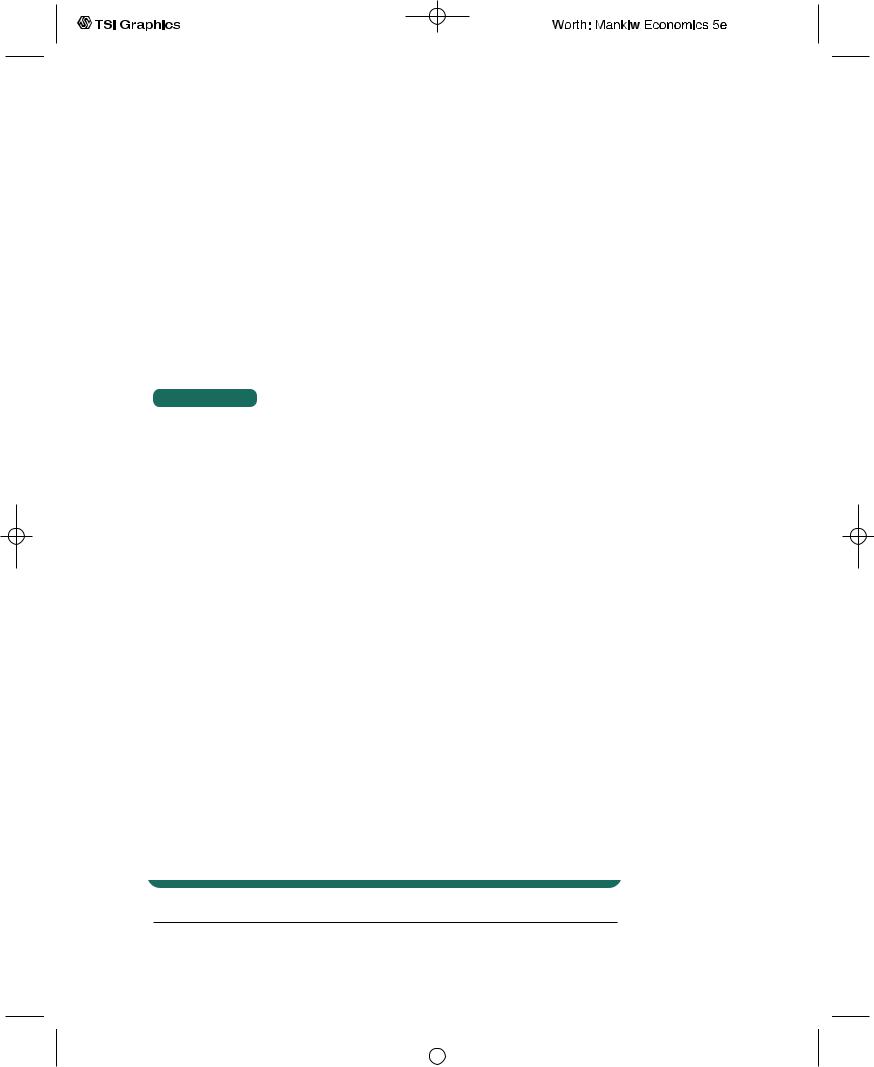
C H A P T E R 1 4 Stabilization Policy | 387
economic fluctuations. The historical record often permits more than one interpretation.
The Great Depression is a case in point. Economists’ views on macroeconomic policy are often related to their views on the cause of the Depression. Some economists believe that a large contractionary shock to private spending caused the Depression. They assert that policymakers should have responded by stimulating aggregate demand. Other economists believe that the large fall in the money supply caused the Depression. They assert that the Depression would have been avoided if the Fed had been pursuing a passive monetary policy of increasing the money supply at a steady rate. Hence, depending on one’s beliefs about its cause, the Great Depression can be viewed either as an example of why active monetary and fiscal policy is necessary or as an example of why it is dangerous.
C A S E S T U D Y
Is the Stabilization of the Economy a Figment of the Data?
Keynes wrote The General Theory in the 1930s, and in the wake of the Keynesian revolution, governments around the world began to view economic stabilization as a primary responsibility. Some economists believe that the development of Keynesian theory has had a profound influence on the behavior of the economy. Comparing data from before World War I and after World War II, they find that real GDP and unemployment have become much more stable.This, some Keynesians claim, is the best argument for active stabilization policy: it has worked.
In a series of provocative and influential papers, economist Christina Romer has challenged this assessment of the historical record. She argues that the measured reduction in volatility reflects not an improvement in economic policy and performance but rather an improvement in the economic data. The older data are much less accurate than the newer data. Romer claims that the higher volatility of unemployment and real GDP reported for the period before World War I is largely a figment of the data.
Romer uses various techniques to make her case. One is to construct more accurate data for the earlier period.This task is difficult because data sources are not readily available. A second way is to construct less accurate data for the recent period—that is, data that are comparable to the older data and thus suffer from the same imperfections. After constructing new “bad’’ data, Romer finds that the recent period appears almost as volatile as the early period, suggesting that the volatility of the early period may be largely an artifact of data construction.
Romer’s work is part of the continuing debate over whether macroeconomic policy has improved the performance of the economy. Although her work remains controversial, most economists now believe that the economy in the aftermath of the Keynesian revolution was only slightly more stable than it had been before.3
3 Christina D. Romer, “Spurious Volatility in Historical Unemployment Data,’’ Journal of Political Economy 94 (February 1986): 1–37; and Christina D. Romer, “Is the Stabilization of the Postwar Economy a Figment of the Data?’’ American Economic Review 76 ( June 1986): 314–334.
User JOEWA:Job EFF01430:6264_ch14:Pg 387:27873#/eps at 100% *27873* |
Mon, Feb 18, 2002 1:03 AM |
|||
|
|
|
|
|
|
|
|
|
|

388 | P A R T V Macroeconomic Policy Debates
C A S E S T U D Y
The Remarkable Stability of the 1990s
Although economists who take a long historical view debate how much the economy has stabilized over time, there is less controversy about the more recent experience. Everyone agrees that the decade of the 1990s stands out as a period of remarkable stability for the U.S. economy.
Table 14-1 presents some statistics about economic performance for the last five decades of the twentieth century.The three variables are those highlighted in Chapter 2: growth in real GDP, inflation, and unemployment. For each variable, the table presents the average over each decade and the standard deviation. The standard deviation measures the volatility of a variable: the higher the standard deviation, the more volatile the variable is.
t a b l e 1 4 - 1
The U.S. Macroeconomic Experience, Decade by Decade
|
1950s |
1960s |
1970s |
1980s |
1990s |
Real GDP Growth |
|
|
|
|
|
Average |
4.18 |
4.43 |
3.28 |
3.02 |
3.03 |
Standard deviation |
3.89 |
2.13 |
2.80 |
2.68 |
1.56 |
Inflation |
|
|
|
|
|
Average |
2.07 |
2.33 |
7.09 |
5.66 |
3.00 |
Standard deviation |
2.44 |
1.48 |
2.72 |
3.53 |
1.12 |
Unemployment |
|
|
|
|
|
Average |
4.51 |
4.78 |
6.22 |
7.27 |
5.76 |
Standard deviation |
1.29 |
1.07 |
1.16 |
1.48 |
1.05 |
Note: Real GDP growth is the growth rate of inflation-adjusted gross domestic product from four quarters earlier. Inflation is the rate of change in the consumer price index over the previous 12 months. Unemployment is the monthly, seasonally adjusted percentage of the labor force without a job.
Source: Department of Commerce, Department of Labor, and author’s calculations.
One striking result from this table is the low volatility of the 1990s.The averages for real growth, inflation, or unemployment are not unusual by historical standards, but the standard deviations of these variables are the smallest ever seen. Moreover, the changes are large. For instance, the standard deviation of inflation was 24 percent lower in the 1990s than it was in the 1960s—the second most stable decade.
What accounts for the stability of the 1990s? Part of the answer is luck.The U.S. economy did not have to deal with any large, adverse supply shocks, such as the oil-price shocks of the 1970s. Part of the answer is also good policy. Many economists give credit to Alan Greenspan, who was chairman of the Federal
User JOEWA:Job EFF01430:6264_ch14:Pg 388:27874#/eps at 100% *27874* |
Mon, Feb 18, 2002 1:03 AM |
|||
|
|
|
|
|
|
|
|
|
|
